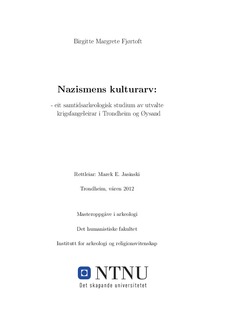| dc.contributor.advisor | Jasinski, Marek Edward | nb_NO |
| dc.contributor.author | Fjørtoft, Birgitte Margrete | nb_NO |
| dc.date.accessioned | 2014-12-19T13:04:27Z | |
| dc.date.available | 2014-12-19T13:04:27Z | |
| dc.date.created | 2012-09-05 | nb_NO |
| dc.date.issued | 2012 | nb_NO |
| dc.identifier | 549687 | nb_NO |
| dc.identifier.uri | http://hdl.handle.net/11250/242907 | |
| dc.description.abstract | The Second World War was the most extensive military conict in the 20th century. During the war millions of prisoners of war (POWs) and foreign workers were used in the German economy to help the war eort. After the invasion of Norway thousands of these were transferred north to build Festung Norwegen, and prepare what was seem from the German side as one of the most critical areas to defend. Many in the Nazi high command assumed that the outcome of the war would be settled here. The POWs were placed in dierent camps, and controlled by a comprehensive prisoner system.
This Master thesis is a modern archaeological contribution to the interdisciplinary research project Painful Heritage, and it focuses on increasing the awareness of the cultural landscape and material culture from the POW camps in Norway. This is something that has received little attention until today.
The main focus of the thesis is to locate, evaluate and analyze the conservation status of some POW camps in Trondheim and ysand, in the context of modern archaeology. In this work, a wide scope of sources and material is used and evaluated as a whole. In Trondheim, the POWcamps that are located and analyzed is; Strindheim, Rotvoll, Korsvika and Blindeskolen. At ysand another four camps are also located and analyzed.
The analysis of the camps in Trondheim shows that only Rotvoll has remaining visible structures from the POW camp, while the other three areas are developed for houses. Despite this, they still oer an archaeological potential as the settlement has not changed since the rst development of the area after the war.
The analysis of Øysand shows that no POW camp areas are or have been developed for housing after the war, but they have been and is used for agriculture. There are few visible remaining structures originating from the camps, although 3 wells, cement remnants and a barrack is registered. As the camp areas have not been used for settlement after the war, makes them archaeologically interest due to the potential material culture in and under the topmost layer of soil. The challenge is that agriculture activities might have aected the subsurface structures signi cantly. It is also located in a closed waste pits with high archaeological potential at ysand.
The landscapes and material culture from the POW camps are an enormous source of knowledge that can increase the understanding and insight on how people in captivity were treated during the Second World War. It is therefore very important that such remnants are recognized as source material and not undermined. | nb_NO |
| dc.language | nor | nb_NO |
| dc.publisher | Norges teknisk-naturvitenskapelige universitet, Det humanistiske fakultet, Institutt for arkeologi og religionsvitenskap | nb_NO |
| dc.subject | Humanities, Theology | en_GB |
| dc.subject | andre verdenskrig | no_NO |
| dc.subject | krigsfanger | no_NO |
| dc.title | Nazismens kulturarv: eit samtidsarkeologisk studium av utvalte krigsfangeleirar i Trondheim og Øysand | nb_NO |
| dc.type | Master thesis | nb_NO |
| dc.source.pagenumber | 105 | nb_NO |
| dc.contributor.department | Norges teknisk-naturvitenskapelige universitet, Det humanistiske fakultet, Institutt for arkeologi og religionsvitenskap | nb_NO |
